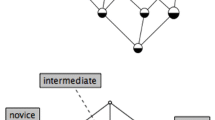Abstract
The quantity of unstructured and semi-structured data available is growing rapidly. Adding structure to such data by grouping similar items into fuzzy categories (or granules) can be a productive approach, and can lead to additional knowledge (e.g. by monitoring association and other relations between classes). Formal concept analysis (and fuzzy formal concept analysis) enables us to identify hierarchical structure arising from similarities in attribute values. However, in an environment where source data is updated, this data-driven approach may lead to concept lattices whose structure varies over time (that is, the number of concepts and their relation to each other may change significantly as updates are processed). In this paper, we describe a novel way of measuring the distance between concept lattices. The method can be applied to comparison of lattices derived from the same set of objects using different attributes or to different sets of objects categorised by the same attributes. We prove that the proposed method is a distance metric and illustrate its use by means of examples.









Similar content being viewed by others
References
Belohlavek R (2002) Fuzzy relational systems. Springer, Berlin
Belohlavek R, Vychodil V (2005) What is a fuzzy concept lattice? In: Proceedings of the international conference on concept lattices and their applications, CLA 2005, Olomouc, Czech Republic, pp 34– 45
Ganter B, Wille R (1998) Formal concept analysis: mathematical foundations. Springer, Berlin
Gennari JH, Langley P, Fisher DH (1989) Models of incremental concept formation. Artif Intell 40:11–61
Hullermeier E, Rifqi M, Henzgen S, Senge R (2012) Comparing fuzzy partitions: a generalization of the Rand index and related measures. IEEE Trans Fuzzy Syst 20(3):546–556
Kuhn HW (1955) The Hungarian method for the assignment problem. Naval Res Logist 52(1):7–21
Li P, Wu X, Hu X (2012) Mining recurring concept drifts with limited labeled streaming data. ACM Trans Intell Syst Technol 3(2):1–32. doi:10.1145/2089094.2089105
Martin TP, Azvine B (2013) The X-mu approach: fuzzy quantities, fuzzy artithmetic and fuzzy association rules. In: Proceedings of the IEEE symposium on the foundations of computational intelligence, Singapore, 2013. IEEE Press (accepted for publication)
Martin TP (2013) Dynamic and evolving fuzzy concept lattices. In: Proceedings of the IEEE symposium on evolving and adaptive intelligent systems, Singapore, 2013. IEEE Press (accepted for publication)
Martin TP, Majidian A (2010) Fuzzy measurement of concept evolution in structured data. Europe Patent EP2413253
Martin TP, Majidian A (2013) Finding fuzzy concepts for creative knowledge discovery. Int J Intell Syst 28(1):93–114. doi:10.1002/int.21576
Martin TP, Majidian A, Cintra ME (2011) Fuzzy formal concept analysis and algorithm. In: Proceedings of the UK computational intelligence (UKCI 2011), Manchester, UK, pp 61–67
Meila M (2007) Comparing clusterings—an information based distance. J Multivar Anal 98(5):873–895
Navarro G (2001) A guided tour to approximate string matching. ACM Comput Surv 33(1):31–88
Priss U (2006) Formal concept analysis in information science. Annu Rev Inf Sci Technol 40:521–543
Sowa JF (1984) Conceptual structures. Addison Wesley, Reading
Stepp RE, Michalski RS (1986) Conceptual clustering: inventing goal oriented classifications of structured objects. In: Michalski RS, Carbonell JG, Mitchell TM (eds) Machine learning: an artificial intelligence approach, vol 2. Morgan Kauffmann, San Mateo
Tversky A (1977) Features of similarity. Psychol Rev 84(4):327–352
Yager RR (1986) On the theory of bags. Int J Gen Syst 13:23–37
Author information
Authors and Affiliations
Corresponding author
Additional information
Communicated by G. Acampora.
Rights and permissions
About this article
Cite this article
Martin, T.P., Abd Rahim, N.H. & Majidian, A. A general approach to the measurement of change in fuzzy concept lattices. Soft Comput 17, 2223–2234 (2013). https://doi.org/10.1007/s00500-013-1095-6
Published:
Issue Date:
DOI: https://doi.org/10.1007/s00500-013-1095-6




